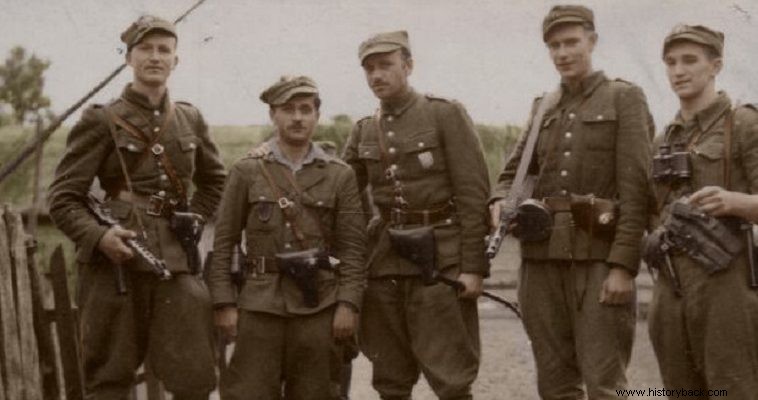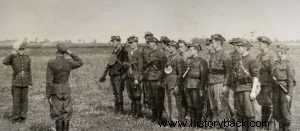
The term "damned soldiers" refers to the Polish fighters who resisted the Soviet yoke, from 1944 until the early 1950s. Similar resistance movements existed in all Eastern European countries that passed under the Stalinist yoke, such as in the Baltic countries - Latvia, Estonia, Lithuania - but also in Romania and Ukraine.
The organization of the "damned" was formed in the last stages of the Second World War, specifically after the revelation by the Germans of the massacre of Polish officers in the Katyn forest by the Stalinist regime. The fighters of many Polish resistance organizations became known by this name , which recognized the government-in-exile in London as the legitimate Polish government. Clashes with the Soviets - and even with Soviet partisans - actually began in the spring of 1943, under the responsibility of the Soviets, and intensified after the summer of 1944 , when the Soviet armies crushed the German Army Group "Center" and advanced into Polish territory.
If Polish patriots still had any doubts about the attitude of the Soviet regime towards them, they soon lost all illusions when the main Polish resistance organization the "Home Army", known by the initials AK, organized the famous uprising of Warsaw (August-October 1944). Then the Soviets who were less than 10 km away from the insurgent positions, not only did not help them, but also banned British and American aircraft to use their territory to supply arms and materials to the insurgent Polish citizens.
“Reactive lacquers…”
As if this were not enough, the Soviets launched an unprecedented propaganda attack against the insurgent Polish patriots, characterizing them, in their favorite tactic, which they also followed in Greece, as "lackees of Nazism" and traitors , supporting the self-controlled communist Polish puppet government of Lublin. In this way Stalin let the Germans do the "dirty" work for him , exterminating the Polish "class enemies". Warsaw was left to be leveled and thousands of Poles were massacred by the Germans.
And yet, all of them, until 1990, were considered traitors to their country and it was forbidden to even mention the Warsaw Uprising. The Poles, for centuries squeezed between two powerful and expansive neighbors , she was afraid that once again she would lose her freedom, which they were the first to defend and fight against Nazism. And they were not wrong, since before their country was even freed, Stalin, with the blessings of Roosevelt and with the Polish communists as his forerunners , like the later general secretary of the Polish CC Władysław Gomulka, Poland's fate was predetermined.
The Pole Gomulka himself declared:"AK fighters are enemies and must be exterminated without mercy"! The Home Army (AK) had been ordered to disarm, on January 19, 1945, by its leadership (the leader at the time was the replacement of the famous General Bor Komorowski, General Leopold Okulitsky), precisely to avoid clashes with the Red Army, which it now possessed all of the pre-war Polish territory.
Although the Soviets had already given samples since 1943, of what was to come . So when the Polish partisans attempted to implement the "Storm" plan, which called for the capture of major Polish cities by AK partisans to prevent their "liberation" by the Soviets, theSoviets reacted and took over armed action against AK. Stalin did not want a free Poland.
The war continues
With the end of World War II in Europe, on May 8, 1945, peace did not return to long-suffering Poland. A new, persistent and merciless "witch hunt" immediately began in all Soviet-occupied territories. Besides, Stalin, as early as December 1943, had signed a relevant order, according to which the Polish, non-communist, rebel groups had to be exterminated.
The best-known Polish organizations that fought against the Soviets were the Freedom and Independence Organization, the National Military Union, the National Armed Forces, the Secret Polish Army, the Home Resistance Army, the Citizens' Home Army', the 'Polish Armed Delegation', 'Independence' known as NIO and 'Freedom and Justice'. Most of them were branches of the Home Army (AK).
The NKVD and its Polish branch, the UB, attempted from the beginning to brutally suppress the "reactionary" Polish fighters, who had been fighting the German occupiers since the winter of 1939. In July 1945, units of the NKVD blockaded the small town of Augustovo, on the current Polish-Lithuanian border. There they arrested 2,000 people. Of these, 600 were executed. Even greater was the massacre of Kakolewnica, near the current Polish-Belarusian border, where 1,800 Poles were executed.
The place of execution, not by chance, was called by the Poles "little Katyn ». In the fall of 1946, for example, they literally massacred 200 Polish fighters of the "National Armed Forces" organization. It is not possible to accurately calculate the number of "damned soldiers" who fell victim to Stalinism in the period 1944-63. However, according to official records, only those executed exceeded 6,000 men and women. Another 21,000 died from torture in prisons and concentration camps.
About 10,000 were killed in the battles with the Soviets and their Polish collaborators. Many others disappeared "secretly", falling victim to the "special death squads" of the communist Polish secret police (UB). Some Khlestias died "of natural causes" shortly after being released fromSoviet concentration camps , because of the "special" treatment they had received.
Over 50,000 were sent to Soviet gulags in Siberia, of whom few returned. Finally, another 250,000 were convicted and served shorter or longer sentences, accused of treason and "political crimes" against the state, while another 6,000,000 Polish nationals were considered "suspects" and at times they went through interrogations and imprisonments! Nevertheless, the resistance continued, until 1963, when the last "damned soldier", Josef Franszak, was killed.

